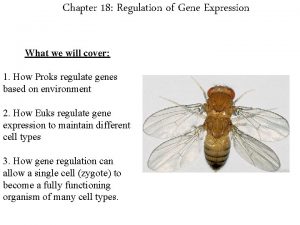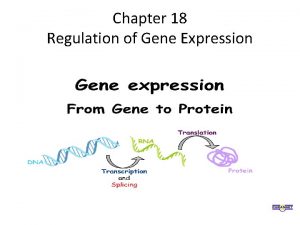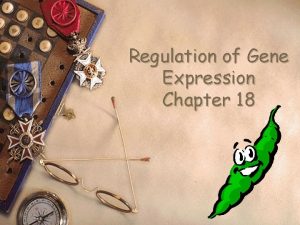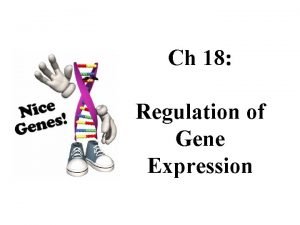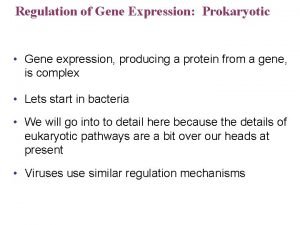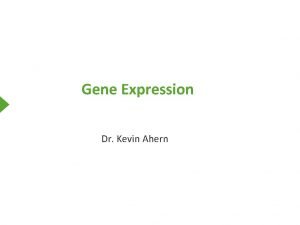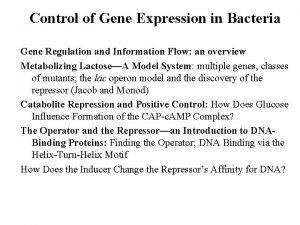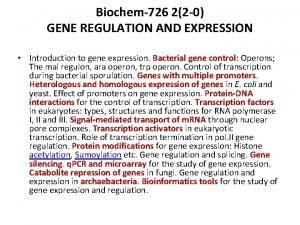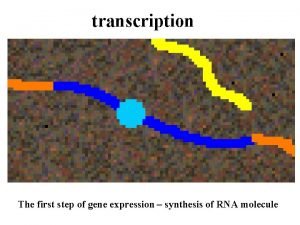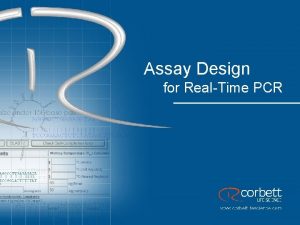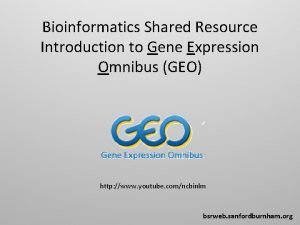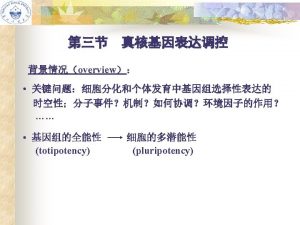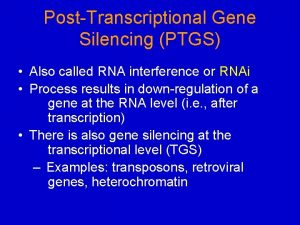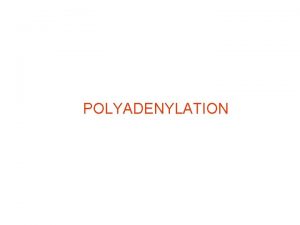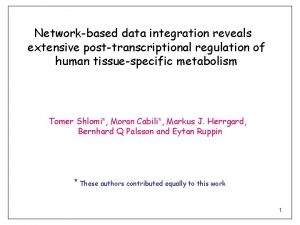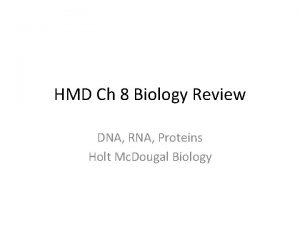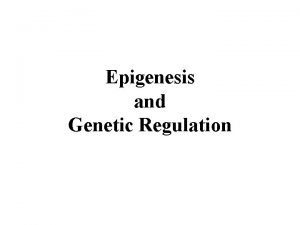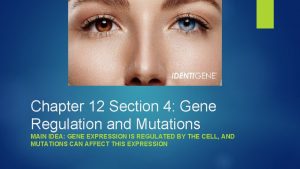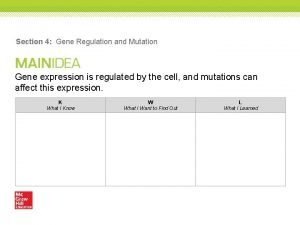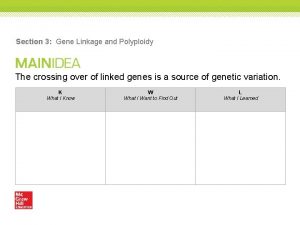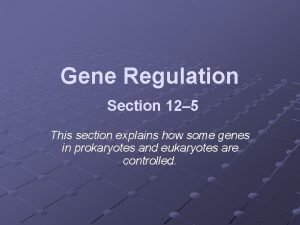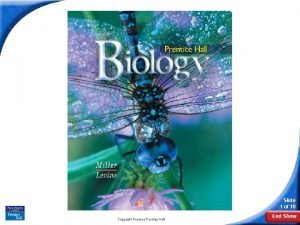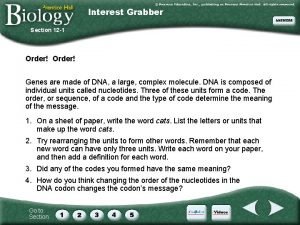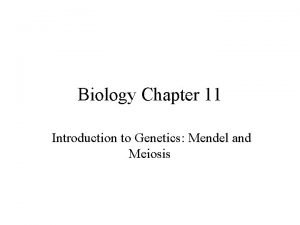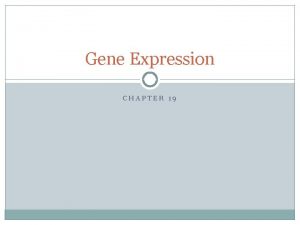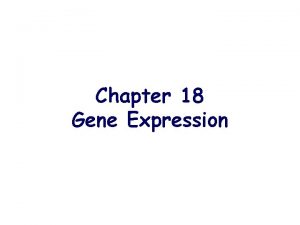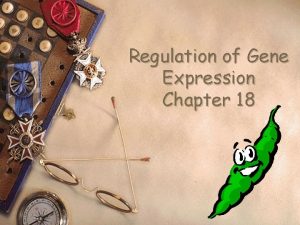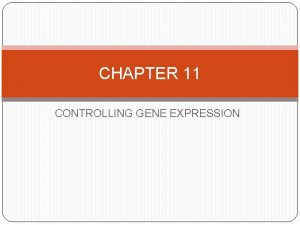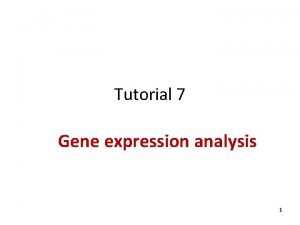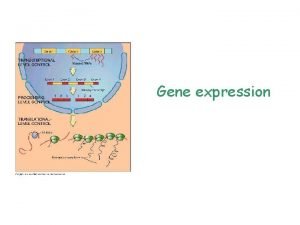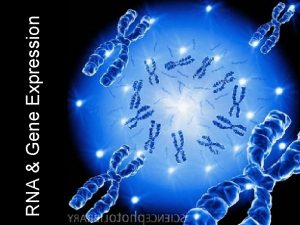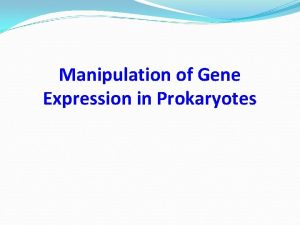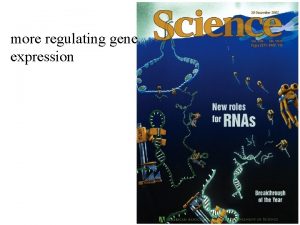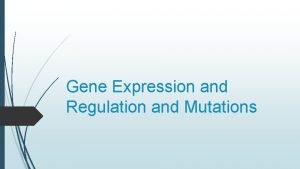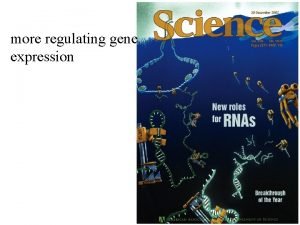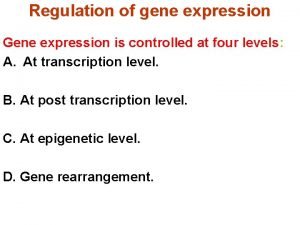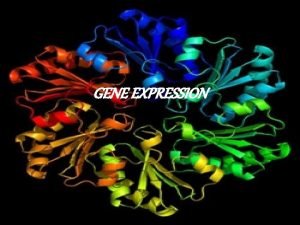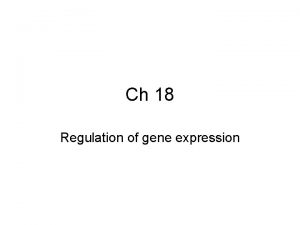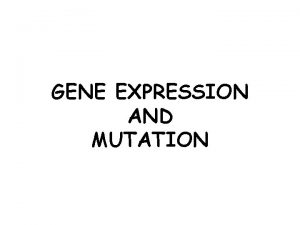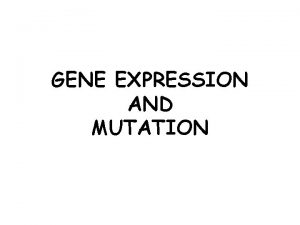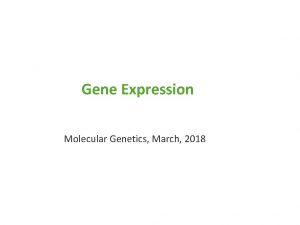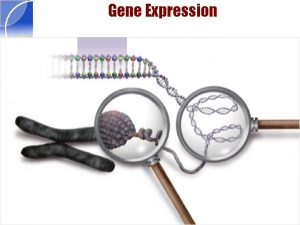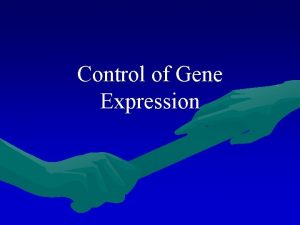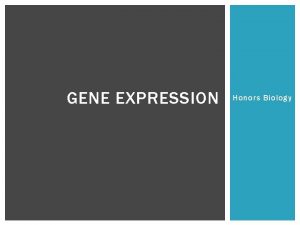Chapter 20 Section 20 2 Gene Expression Gene
































- Slides: 32

Chapter 20 Section 20. 2 Gene Expression

Gene Expression • Specific segments of DNA on a chromosome are called genes. • Genes determine the outward, physical traits of an organism. • The way the information in the DNA sequence for a specific gene gets expressed is through the production of a polypeptide. • This process is known as .

Gene Expression Cont’d • Polypeptides are • More than one polypeptide makes up a . • The proteins produced from the DNA sequences are used to form most structures in an organism, such as skin, muscle and organs, therefore expressing the phenotype of the gene.

Role of RNA • Ribonucleic acid or RNA is a nucleic acid involved in • RNA is different from DNA in 3 ways: 1. The sugar in RNA has an extra hydroxyl (OH) group and is called a

1. Extra Hydroxyl

Role of RNA Cont’d 2. Instead of the nitrogenous base thymine, RNA contains the base Uracil forms a complementary base pair with adenine, like thymine.

2. Uracil instead of Thymine

• 3. RNA is a .

3. Single Strand

3 Types of RNA • There are 3 types of RNA that are needed to convert genes into proteins: 1. Messenger RNA (m. RNA) 2. Transfer RNA (t. RNA) 3. Ribosomal RNA (r. RNA)

Stages of Gene Expression • There are two main stages of gene expression: 1. Transcription – the process of converting DNA into messenger RNA. 2. Translation – the process of converting the messenger RNA into a polypeptide and eventually a protein.

Transcription • During transcription, the DNA sequence of a gene is copied (transcribed) into the sequence of a single stranded • Transcription can be divided into 3 processes: 1. Initiation 2. Elongation 3. Termination

Transcription - Initiation • Transcription starts when an enzyme called binds to the DNA in front of the gene that is about to be copied or transcribed. • This region of initial binding is called the.

Transcription - Elongation • Once the RNA polymerase binds to the promoter it opens up the double helix. • Once the helix is open, it builds the single stranded m. RNA one nucleotide at a time by copying the nucleotides from the DNA. • It copies in the same direction that DNA is replicated, 5’ to 3’. • The DNA strand that is being copied is called the.

Transcription - Termination • Synthesis of the m. RNA continues until RNA polymerase reaches the end of a gene. • RNA polymerase recognizes the end of a gene when it comes to a stop signal called a termination sequence. • A – is a specific sequence of nitrogenous bases that indicates the end of a gene. • Once the termination sequence is reached the m. RNA is released from the template strand of DNA.


BREAK

Translation • Once the sequence of nucleotides is copied to the m. RNA, converts the sequence of bases from the m. RNA into a chain of amino acids, making a polypeptide and eventually a protein. • Translation is essentially protein synthesis.

Amino Acids • There are only 20 different amino acids found in human proteins. • Because of the few number of amino acids compared to the many combinations of sequences of nitrogenous bases that can be formed, a few different nitrogenous base sequences code for the same amino acid. • DNA code is read is groups of 3 nucleotides, called a. • Each codon or group of 3 nucleotides calls for a specific amino acid.


Special Codons • Out of the many DNA codons there are two very special ones: 1. Start codon – a specific codon that signals the start of translation. The specific codon is AUG. 2. Stop codons – specific codons that signal the end of translation. The specific codons are UAA, UAG and UGA.

Translation Cont’d • Translation can also be divided into the same 3 processes as transcription: A. Initiation B. Elongation C. Termination

Translation - Initiation • Initiation of translation occurs when a ribosome recognizes a start codon on the m. RNA and binds to that site. • The of ribosomes in eukaryotes, consist of two subunits, a large and small subunit. The two subunits of r. RNA bind to the m. RNA, clamping it between them. • The ribosome then moves along the m. RNA in the 5’ to 3’ direction, adding a new amino acid to the polypeptide chain each time it reads a codon.


Translation – Initiation Cont’d • The correct amino acids for each codon or sequence are brought to the ribosome by a third type of RNA called t. RNA or transfer RNA. • At one end of the t. RNA molecule is a sequence of three bases that compliments the codons on the m. RNA, called an anticodon. – Ex. m. RNA codon = UAU – t. RNA codon = AUA

Translation – Initiation Cont’d • At the other end of the t. RNA molecule carries the corresponding amino acid for the m. RNA codon. – Ex. m. RNA codon = UAU t. RNA codon = AUA Then amino acid on t. RNA is tyrosine because UAU codes for tyrosine.

Translation - Elongation • The first codon that is recognized is always AUG, the start codon. • AUG corresponds to the methionine amino acid, so every protein in our bodies starts with methionine. • The ribosome has two sites for t. RNA to attach: the A (aminoacyl) site and the P (peptidyl) site.

Translation - Elongation • The t. RNA with the anticodon complimentary to the start codon enters the P site. • The next t. RNA molecule with the anticodon complimentary to the next codon enters the A site. • When both are present in the different sites a peptide bond forms between the two amino acids at the ends of the t. RNA molecules.

Translation - Elongation • Once the bond has formed, the ribosome boots out the t. RNA from the P site, moves the second t. RNA into the P site, leaving the A site open for the next t. RNA molecule. • This action continues adding on each new amino acid depending on each codon of the m. RNA. • The t. RNAs that have been released are recycled back by having new amino acids attached to them. • The process continues until the entire code from the m. RNA has been translated into a polypeptide chain.

Translation - Termination • Eventually, the ribosome reaches one of the three stop codons: UGA, UAG or UAA. • This stops the translation of the m. RNA into amino acids. • At this point a release factor recognizes that the ribosome has stalled and helps release the polypeptide chain from the ribosome. • We have now made a protein from a sequence of DNA. These proteins make up our body structures, expressing our genes physically.


 Chapter 17 from gene to protein
Chapter 17 from gene to protein Chapter 18 regulation of gene expression
Chapter 18 regulation of gene expression Chapter 18 regulation of gene expression
Chapter 18 regulation of gene expression Chapter 18 regulation of gene expression
Chapter 18 regulation of gene expression Chapter 18 regulation of gene expression
Chapter 18 regulation of gene expression Gene by gene test results
Gene by gene test results Poltrp
Poltrp Dr kevin ahern
Dr kevin ahern Regulation of gene expression in bacteria
Regulation of gene expression in bacteria Regulation of gene expression
Regulation of gene expression טרנסלציה
טרנסלציה Genetic effects on gene expression across human tissues
Genetic effects on gene expression across human tissues Is lac operon positive or negative control
Is lac operon positive or negative control Restools
Restools Gene expression omnibus tutorial
Gene expression omnibus tutorial Gene expression
Gene expression Gene expression
Gene expression Gene expression
Gene expression Gene expression
Gene expression Gene regulation
Gene regulation Cells must control gene expression so that __________.
Cells must control gene expression so that __________. Lyonization of gene expression
Lyonization of gene expression Section 4 gene regulation and mutations
Section 4 gene regulation and mutations Chapter 10 section 3 gene linkage and polyploidy
Chapter 10 section 3 gene linkage and polyploidy Quadratic formula examples
Quadratic formula examples Section 4 gene regulation and mutation
Section 4 gene regulation and mutation Section 3 gene linkage and polyploidy
Section 3 gene linkage and polyploidy Section 11-5 linkage and gene maps answer key
Section 11-5 linkage and gene maps answer key Section 12-5 gene regulation
Section 12-5 gene regulation 11-5 linkage and gene maps
11-5 linkage and gene maps Section 12-1 dna
Section 12-1 dna Section 11-5 linkage and gene maps answer key
Section 11-5 linkage and gene maps answer key Chapter 10 section 1 meiosis answer key
Chapter 10 section 1 meiosis answer key

